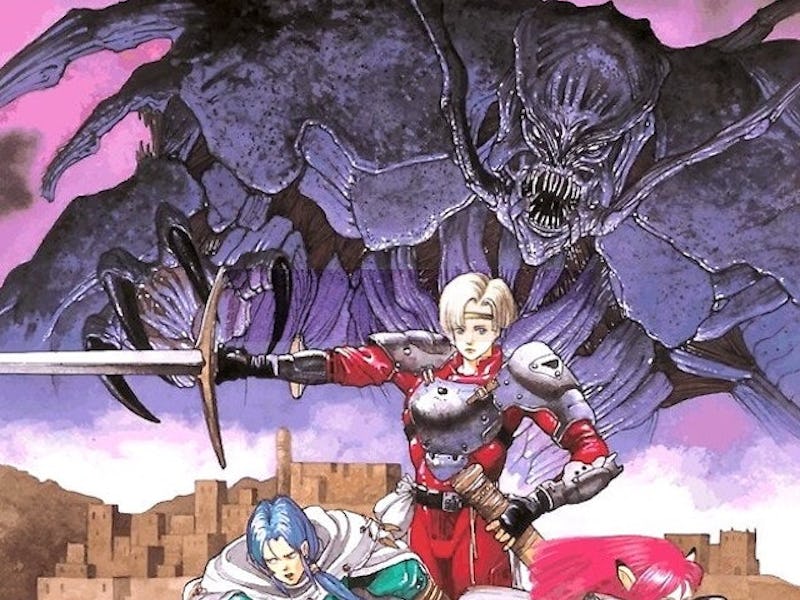You need to play Sega’s most stylish RPG ever on Nintendo Switch ASAP
Science fiction meets fantasy...

In 1986, games publisher Enix released the RPG Dragon Quest in conjunction with the developer Chunsoft. Taking place in a medieval fantasy land of kings and princesses, Dragon Quest would set the standard for Japanese role-playing games (JRPGs). The next year, the very first Final Fantasy game arrived. The subgenre pretty much exploded leading into the ‘90s. Even Sega created a series of its own — and the fourth game in said series is an iconic finale worth checking out ASAP if you’re subscribed to Nintendo Switch Online + Expansion Pack.
JRPGs offered fascinating new experiences for Japanese players in the late ‘80s. Most games were single-player experiences where you controlled one character, but JRPGs often involved managing a party and balancing the strengths and weaknesses of its members. Personalities clash as often as swords and shields, so it created a kind of dramatic storytelling with a lot of depth.
It makes sense that a game called Phantasy Star would collide sci-fi and fantasy.
In 1987, Sega was developing its own JRPG. Released only two days after Final Fantasy, the original Phantasy Star hit Sega’s Master System. It was one of the most technologically advanced games of its time. With a 4 megabit chip and a cutting-edge battery driving prices up for the game itself, many reviewers thought they had found the future of video games but were faced with recommending an unusually expensive game.
Both series would remain popular, although Final Fantasy would prove to be the dominant between the two, as often happened in competitions between Nintendo and Sega. In 1993, the Phantasy Star franchise decided to hang things up on its own terms. Coming to an end after four games, Phantasy Star IV: The End of the Millennium ended the narrative on a high note. And it's available right now if you’ve subscribed to Nintendo Switch Online + Expansion Pack.
After Phantasy Star III had pushed the game into a sci-fi future, PSIV returned to its more magic-based past. Motavia is a world of science and magic, although that hasn’t helped the planet much. Things are looking bad, with climate change and decreasing birth rates, but most notably all the monster attacks. Developer Rieko Kodama told a gaming magazine in 1993 that “the world of Phantasy Star IV came into view for us very incrementally.”
Combat unfolds in this very interesting and unique perspective.
“Take a single candle, for instance: We asked ourselves, would that be something you’d find in this world? Is there electricity? Do the windows have curtains, drapes, shades…? Just a lot of little details like that,” Kodama said. “For the characters, we figured out most of their personalities as we drew them. With each detail and bit of background we added to the characters, the story itself also expanded.”
All of this detail might not be readily apparent as protagonist Chaz Ashley wakes and is informed by fellow bounty hunter Alys Brangwin that he is no longer her trainee, but her partner. PSIV is meant to take place after the events of PSII, which means new players might be a little lost in all the relationships, but the dialog clears things up. Have party-leader Alys look at some non-interactive element, and she’ll scold you for wasting time when nothing’s there. Meanwhile, Chaz can't stop looking at the books inside the academy that’s hired them to clear out some monsters.
Alys has a commanding presence, one she uses on monsters and on people who want her help. When she confronts the head of the academy on the monsters appearing in the basement (frankly a fair question for any administrator), the old man folds. The problem of the monsters lies in the mystical Birth Valley, but he hasn’t sent expeditions exploring because of a mysterious dark magician named Zio, who has threatened to turn him into stone. And to prove he wasn’t bluffing, Zio turned a team of students into stone.
It truly is ... beautiful.
The cut scenes in PSIV are lovely, meant to evoke pages from manga more than anything animated. The visuals are classic 16-bit beauty, from the main characters to the randomly generated enemies they get when roving from town to town, trying to find out more about Zio’s diabolical power.
PSIV was not a game bent on turning over the apple cart. The series had already featured an experimental entry, PSIII, and while that game had its fans, the team behind the first two games was brought back for the finale. PSIV shows the sheer depth of what a Genesis game could do, which is why it’s worth playing today, even if you’ve never played a minute of the series before.